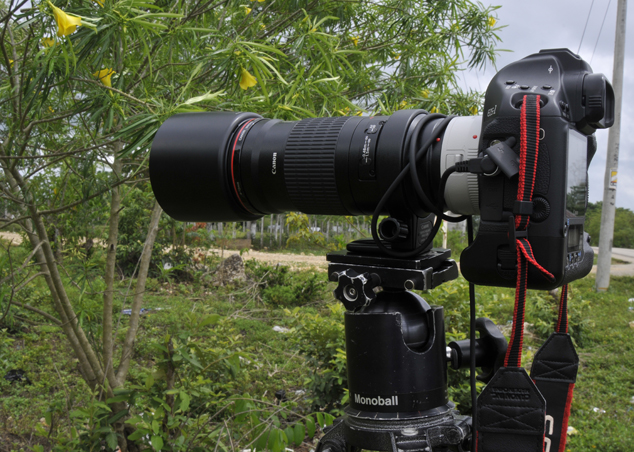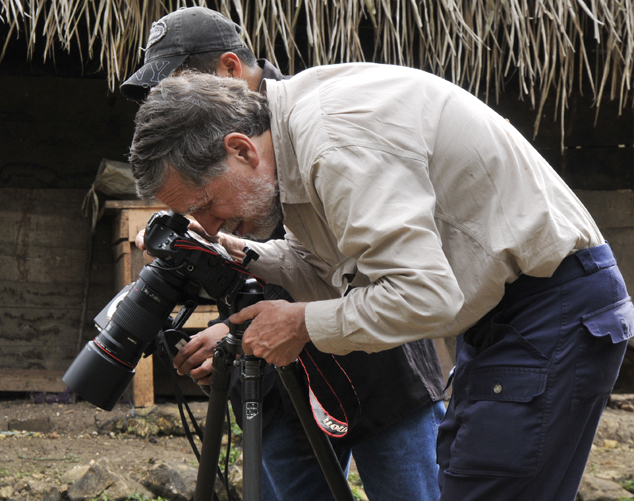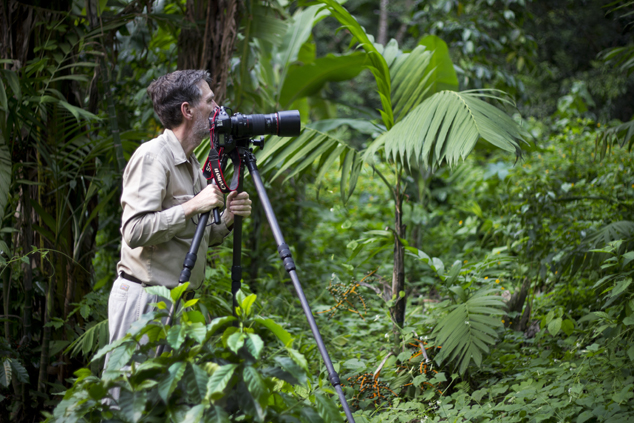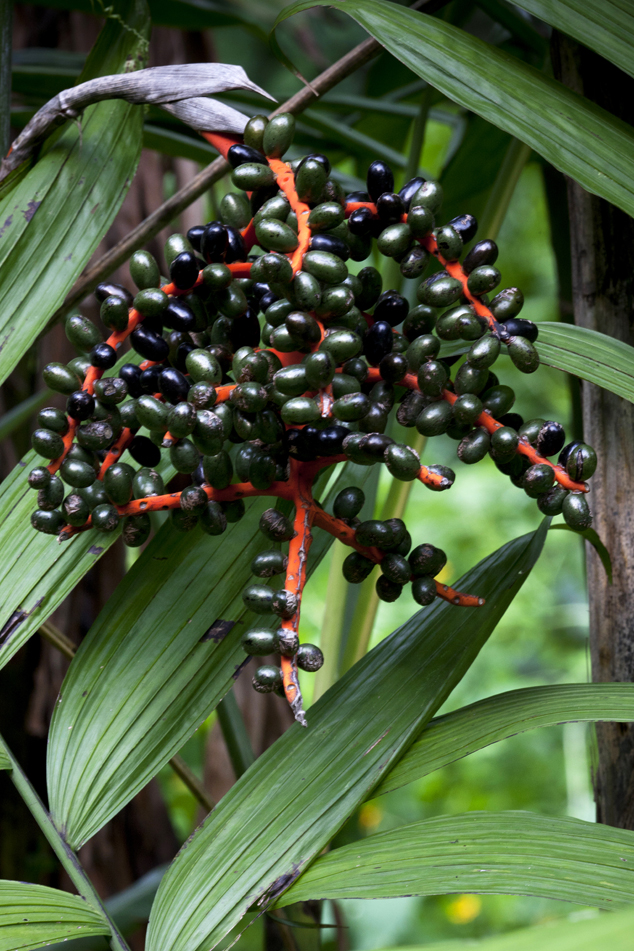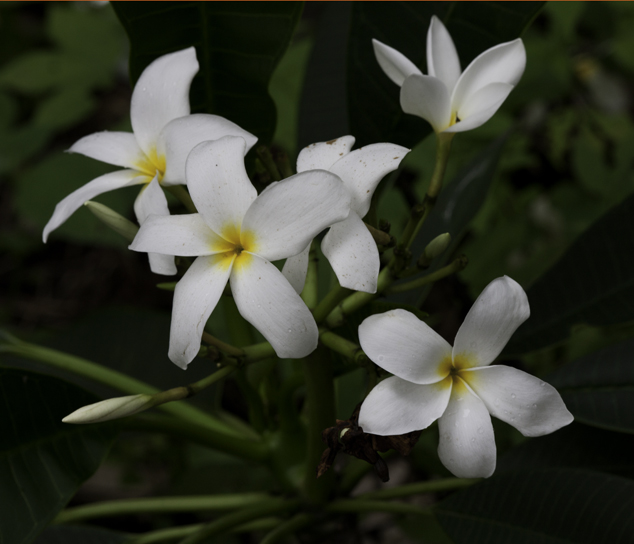Telephoto-macro lenses are essential for field photography in botany
Telephoto lenses are primarily for sports reports and bird photographers. But telephoto lenses are also essential for field photography in botany.
Why would you need a telephone lens for photographing flowers?
If you need to photograph the flowers of a vine that flowers primarily high up in a tree. Or if you need to photograph the flowers of a bromeliad (which tends to be high in a tree).
Or if you photograph the fruits of a philodendron or comparable vine: these tend to be high up in a tree. So you need at least a 180mm tale photo. And often a 1.4x tele-extender is essential.
The FLAAR photo teams and botanists have learned that you can’t do adequate botanical photography out in a tropical rain forest region unless you have this kind of a lens. The lens we prefer is a Canon EF 180mm f/3.5 L USM tele-macro lenses, usually plus a 1.4x tele extender.
Canon EOs 1Ds Mark III with a EF 180mm f/3.5 L USM tele-macro lens plus a 1.4x tele-extender,
Guatemala December 2010.
35mm vs medium format for botanical photography in the field
At FLAAR we have available large-format digital cameras and lenses, medium format cameras and lenses, and 35mm digital cameras and lenses (both Nikon and Canon).
For telephoto photography of birds you need a mobile system. So medium format is at a disadvantage because of the weight. Plus, for tele-macro, the object you are photographing is rarely more than 25 x 40 centimeters in size, so a medium format is not that much extra help. The 21 megapixel Canon EOS-1Ds Mark III is fine.
Yes, medium format is a tad better, but I do not know of any realistic tele-macro system for medium format. What Canon provides with their 180mm telephoto-macro lens is plenty good enough.
Nicholas photographing flora and fauna in tropical rain forest in native house with a Canon EOs 1Ds Mark III plus a EF 180mm telephoto-macro lens, Sayaxche Petén Guatemala December 2010.
For panoramas, for macro of objects that don’t need a telephone, for all that we get outstanding results with medium format lens quality and a medium format digital back (we prefer Zeiss lenses and a Phase One digital back). But for telephone photography, and especially tele-macro, 35mm DSLR is fine.
Close-up lens adapter
We also wish to use a Canon close-up lens 500D; this is a circa $300+ adapter adapter, not a $10,000+ 500mm lens. The 500D has been listed on web sites but totally unavailable (even before the catastrophic earthquake and tsunami in Japan).
The purpose of the 500D lens adapter (which I assume goes on the front end) is to turn the 100-400mm zoom lens into a zoom-telephoto-macro.
I am not yet familiar with anything that can turn a 500mm prime telephoto lens into a tele-macro. And the 100-400mm telephoto zoom is more versatile. Plus the 500D accessory, 77mm diameter size, fits the 100-400mm lens.
Nicholas photographing birds in tropical rain forest with a Canon EOs 1Ds Mark III and 100-400mm telephoto zoom lens,
Sayaxche Petén Guatemala 2010.
1.4x tele-extender is essential also
Most major camera brands offer a 1.4x tele-extender and a 2x tele-extender. With Canon, I believe that the 2x does not facilitate automatic focusing. So we opted for the 1.4x.
When you are doing field work out in the swamps or forests or savannas, we highly recommend you have a 1.4x tele-extender. We use it on all our Canon telephoto lenses.
Nicholas photographing pacaya male tree with a Canon EOs 1Ds Mark III and 180mm macro lens.
Palín Escuintla Guatemala April 2011.
Pacaya plant male by Nicholas Hellmuth with a Canon EOs 1Ds Mark III and 180mm macro lens.
Palín Escuintla Guatemala April 2011.
“The full package” for digital macro photography of flowers, fruits, and nuts
We will discuss macro accessories in separate web pages on this Mayan ethnobotanical web site. The present page is to evaluate how to equip your team for botanical (and zoological) field photography, we suggest (for telephoto needs)
- Canon EOS 1Ds Mark III camera body
- 32 MB RAW Hoodman brand memory card
- Canon cable release
- 180mm Canon tele-macro lens
- 100-400mm telephoto zoom lens
- with 500D lens adapter for close-up
- polarizing filter for each lens (be sure you have one that fits the 500D lens adapter).
- Canon 1.4x tele-adapter can be (and should be) used on either lens. Obviously you need only one adapter for your camera, no matter how many lenses you use with it.
Show all of this; most importantly, show us using it out in the field
Nikon offers comparable tele-macro opportunties
The main advantage of reviews from the FLAAR research institute is that we are not beholden to any camera manufacturer. So we have the freedom to write about any and all brands.
The equivalent with Nikon would be a 200mm tele-macro, but there is no super-high-resolution Nikon that matches the Canon EOS-1Ds Mark III (I have been using Nikon cameras for 20 years, and have had a Nikon D100, D200, and D300).
I have a Nikkor 200mm tele-macro lens, but it is over 15 years old, and is manual focus. You often get better focus with auto-focus (especially if you wear eye glasses normally). I do use manual focus often, but I wish to have the option to chose depending on the situation of each shot. Now that I have the Canon auto-focus 180mm tele-macro, I have never touched the Nikkor lens all year (which makes the camera assistants happy, as they can use the Nikon system themselves).
The other reason FLAAR reviews are valued is because we list downsides as well as good features
Most “reviews” are just PR releases commissioned by a commercial company or are issued to collect fees from click-through. Yes, of course our botany research projects have sponsors. I do not know even many universities nowadays that don’t have corporate sponsors. But FLAAR is known for listing features of sponsors products which are inadequate. Actually we do this to assist the sponsor to improve their products.
But Canon is not a sponsor, but still we hope they do use our comments to improve the aspects of their lenses which are embarrassing for their Canon brand name.
I love my Canon EOS-1Ds Mark III. But not all Canon cameras are good; avoid buying a used EOS 5D; and avoid the Canon cameras made four years ago: several models were almost unusable; other models were over-hyped and underpowered. But the EOS-1Ds Mark III is a great camera, and worth its price.
If you are on a budget, some of the EOD 7D models are acceptable for biology students and assistants. But if you do serious photography of plants or animals, you should have a serious camera. If all you do is macro photography, the lens reduction factor is actually a benefit (for macro photography; the lens reduction factor is only a hindrance in wide-angle photography).
After-market lenses and after-market accessories
Canon lens shades are cheap low bid pieces of plastic (even on a multi-thousand dollar lens). Canon lens shades do not easily attach to the lenses they were made for (because the lens shades are so low-bid and shoddy). Furthermore, the attachment ring system is feeble and imprecise. It is an embarrassment for a company that claims a Japanese quality can produce such poorly designed and so obviously low bid components.
Unfortunately I do not know anyone who makes after-market lens shades! And besides, the attachment rings are part of the fault, and these threads are part of the lens. So you are stuck with a low-bid flimsy lens shade (the engineers in Japan should be embarrassed at producing such junk; I wonder if any manager at Canon realizes how loosey these lens shades are.
The other downside of a Canon lens shade design is that it’s hard to hold the lens (when taking it out of your camera case, or out of your lens bag) without using the lens shade as what you hold. But the lens shade is so poorly attached (because of the inept engineering design) that the lens shade falls off the camera… and the thousand-dollar lens falls to the ground and breaks.
Canon “cable releases” are also poorly made
The cable release of Canon is poorly made, but not as useless as their inept lens shades. Nikon cable releases fail eventually, but not as quick as a Canon cable release.
But after-market cable releases are even worse. I bought one from Amazon.com or comparable, and the after-market cable release lasted only a week or so. Junk made in China tends to work just exactly as you expect: low-bid components don’t hold up for more than a few days of use!
None of these comments are intended to have you not buy Canon cameras. Pentax and Olympus could be considered a waste of your biology department budget: their lens reduction factors are so large that you can’t do serious wide-angle photography. 1.4x lens reduction (Nikon D300 for example) is bearable if you have a 15mm super wide-angle lens, but if you constantly need to photograph an entire eco-system, you need a full-frame sensor.
Mayan ethnobotanical photography: especially flowers and fruits
You may notice that our style of photography is different: our lighting for example; our use of polarizing filters (in most cases). This is because our background is in fine art photography (which is also a strength of Parrot Digigraphic).
One of our goals in this web sites in this web site is to produce a new standard in botanical field photography, and in botanical in-house (museum, university department, nature park and/or botanical garden photography).
Flor de mayo white, Plumeria rubra by Nicholas Hellmuth with a Canon EOS 1Ds Mark III.
We hope you enjoy the photographs on this web site.
We will be adding pages next month that discuss how you can print your photographs of flowers, eco-systems, and other aspects of photography of biological subjects.
First posted August 23, 2011


